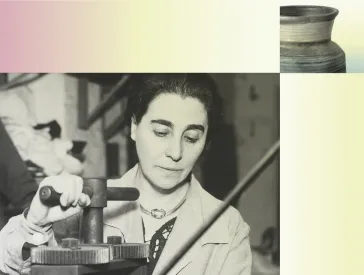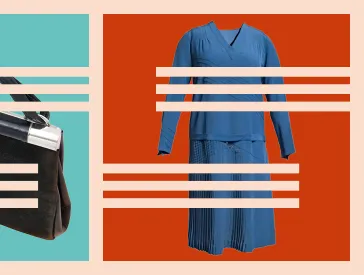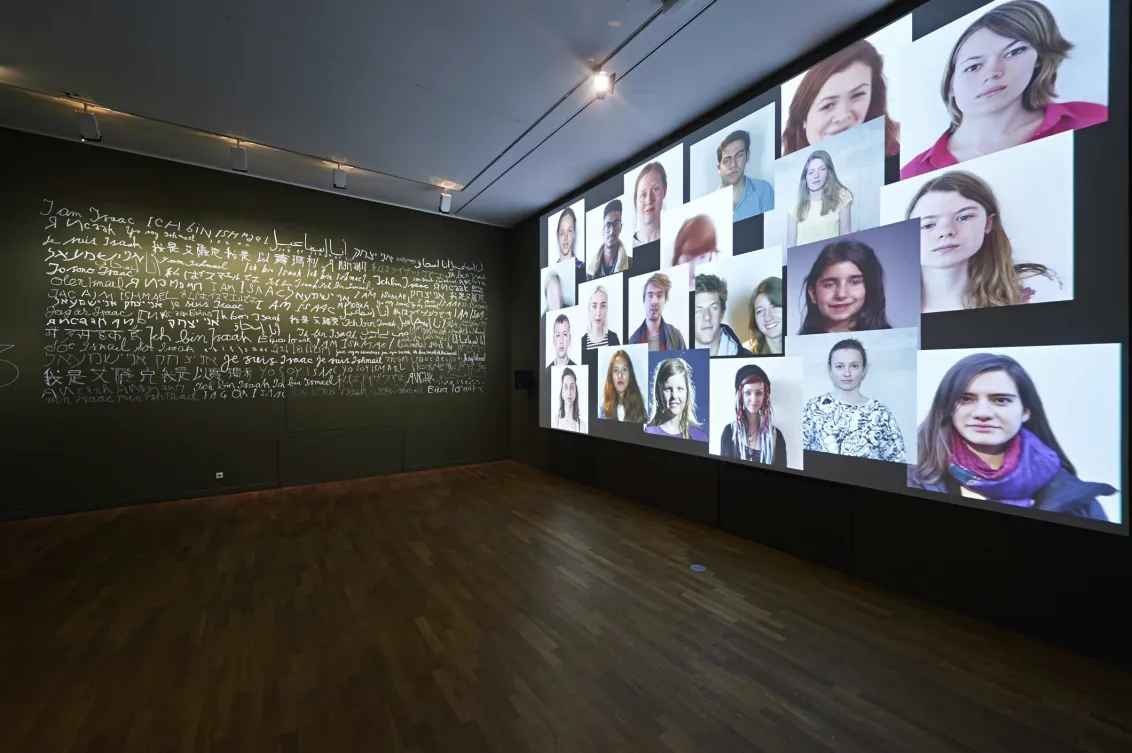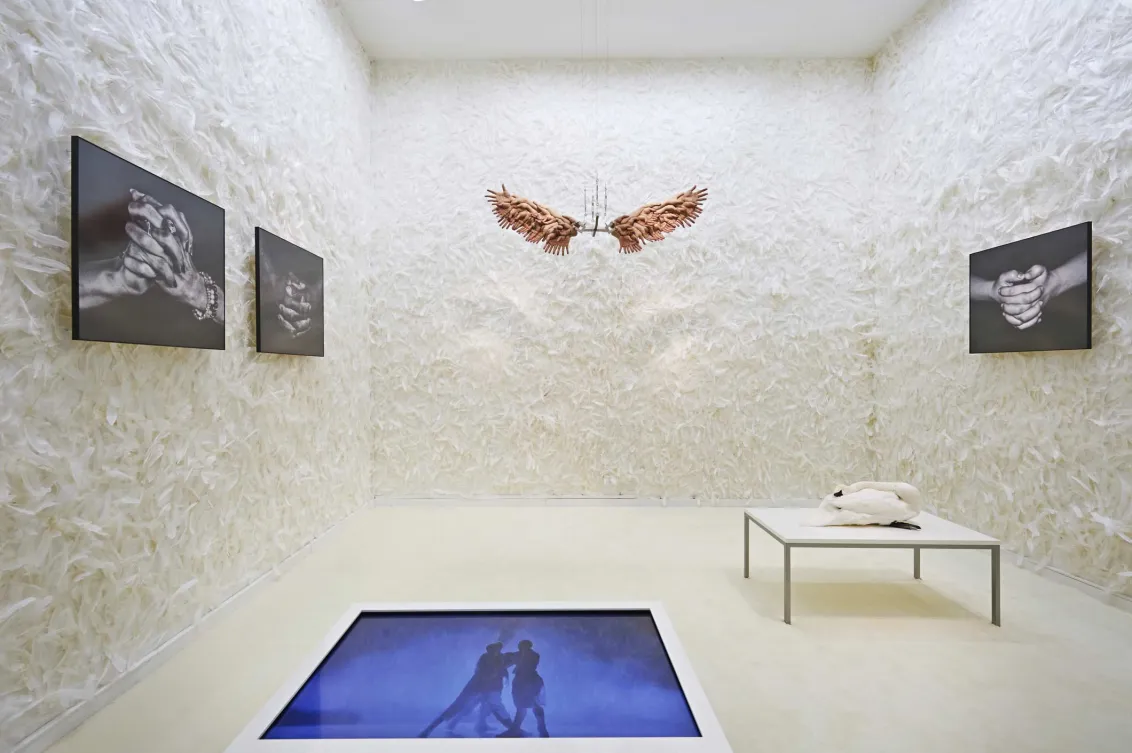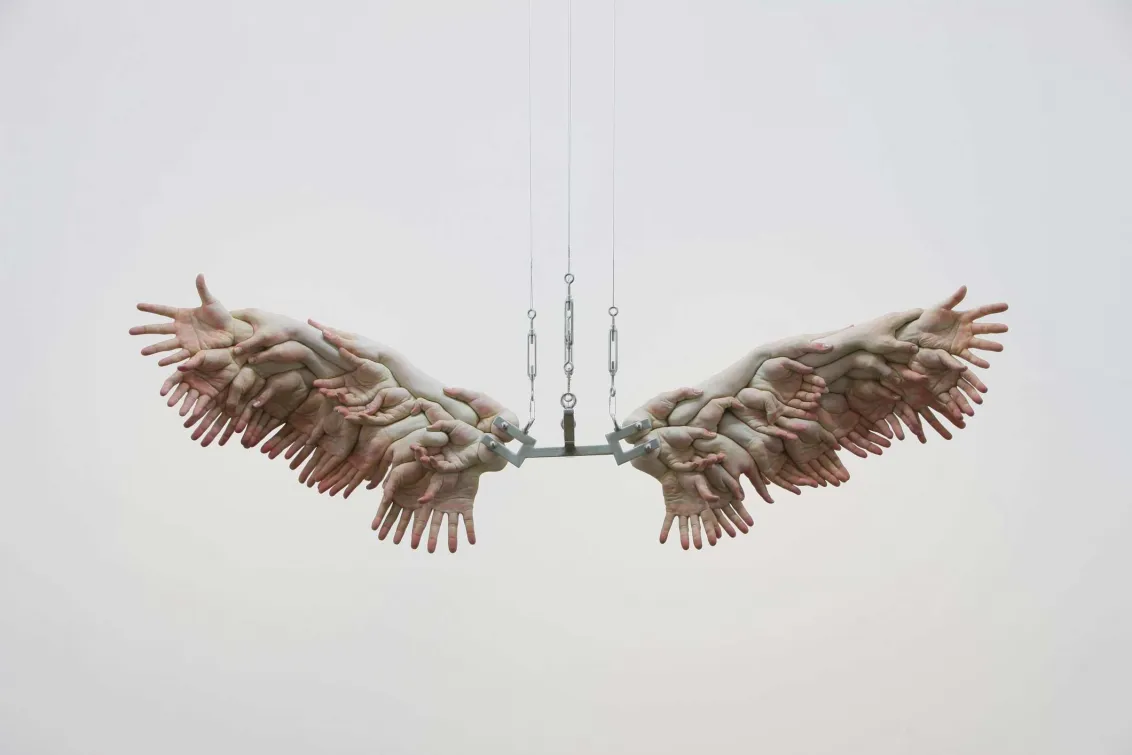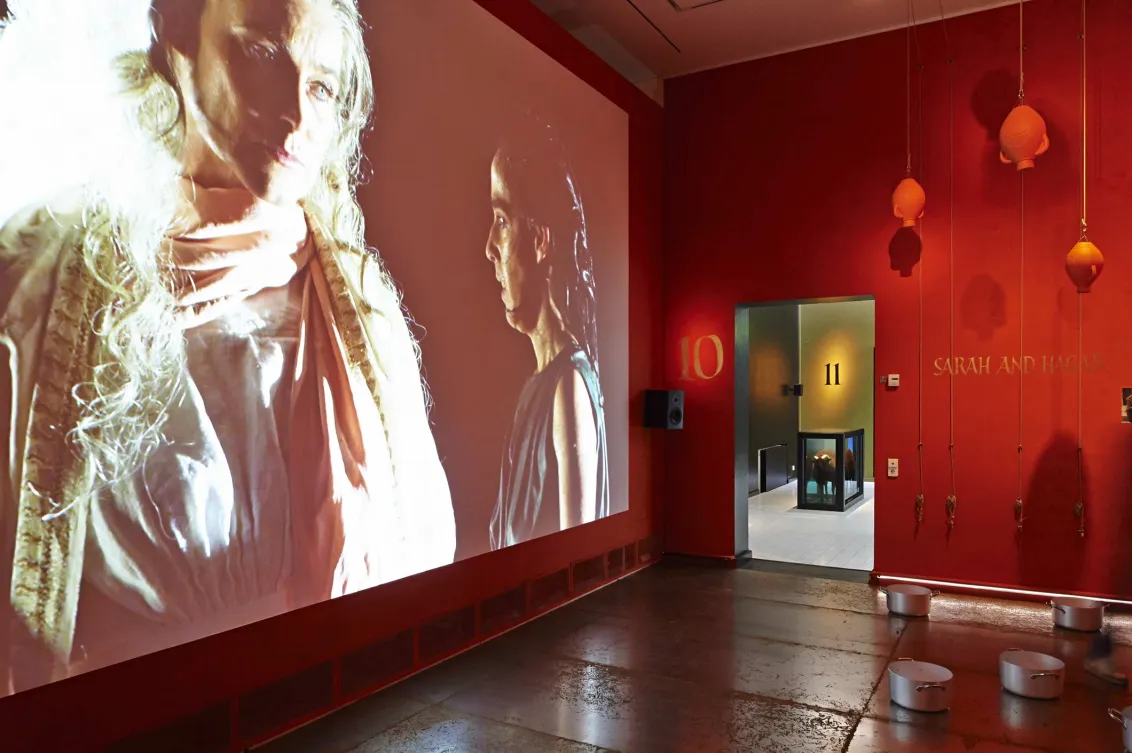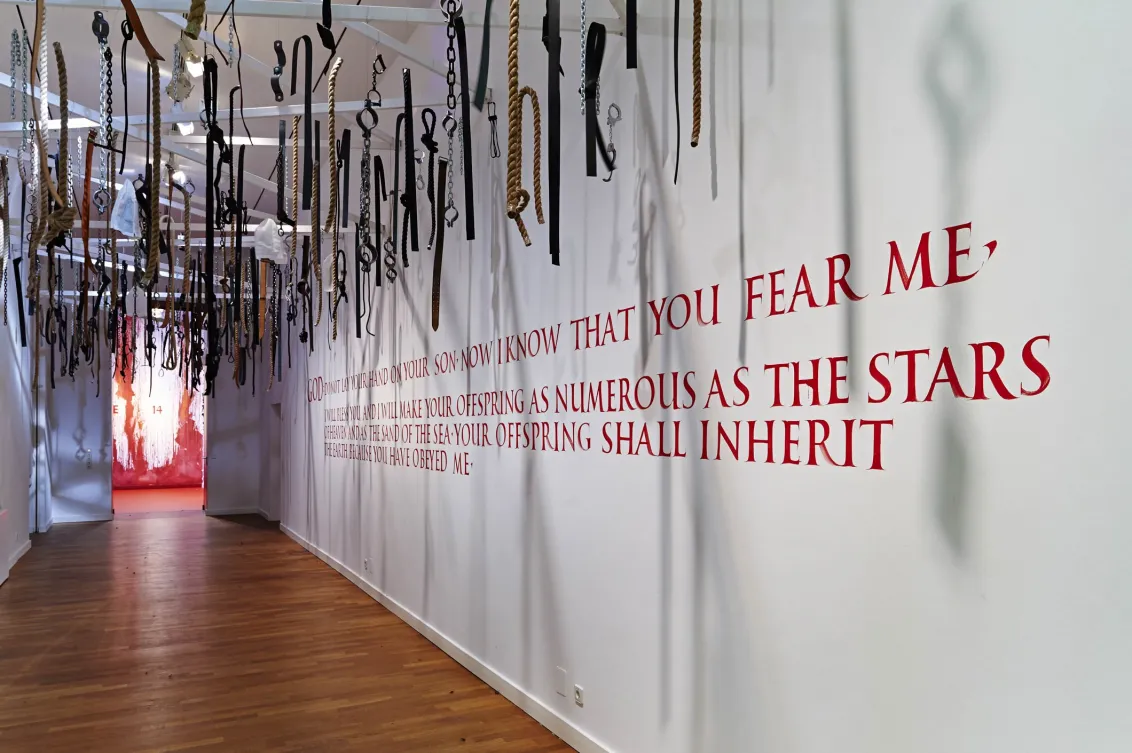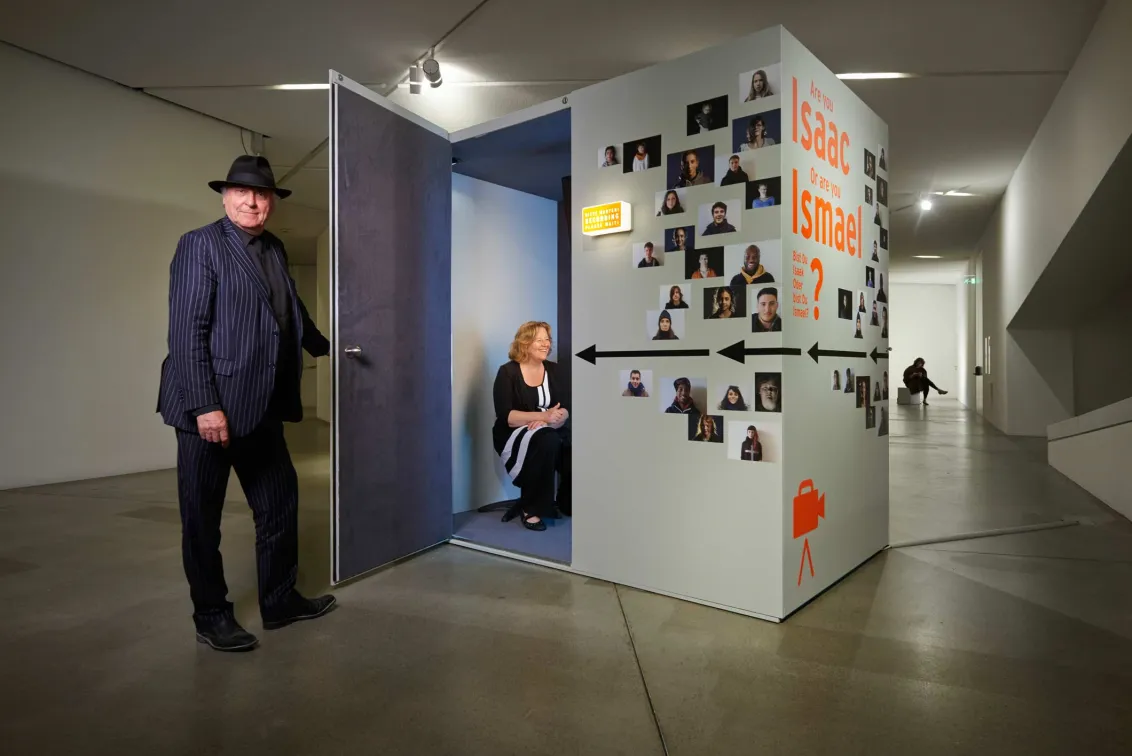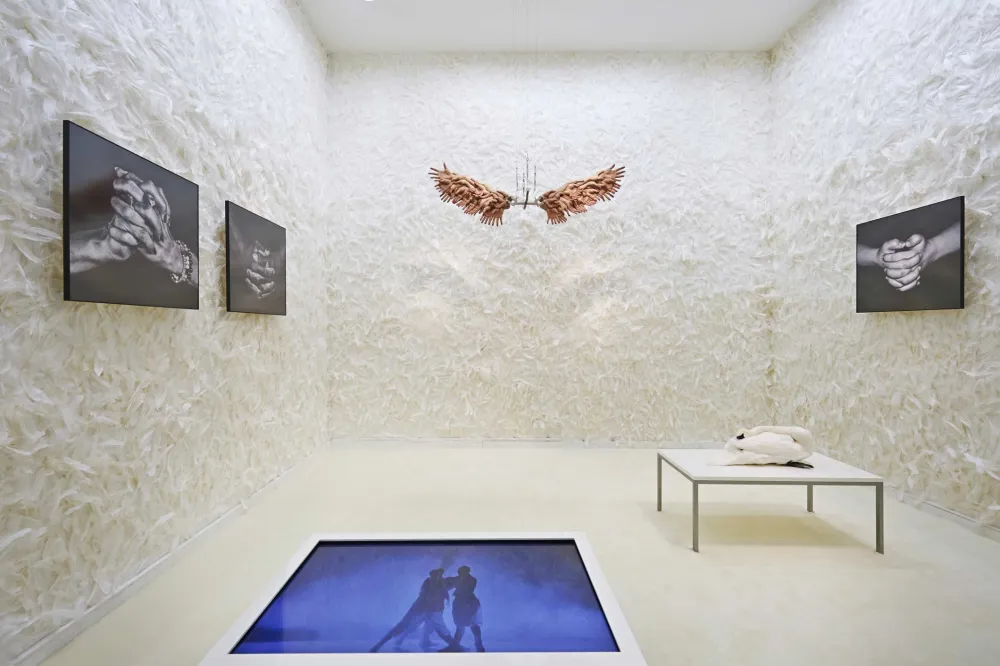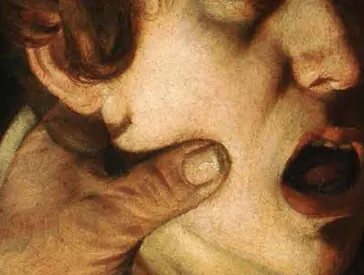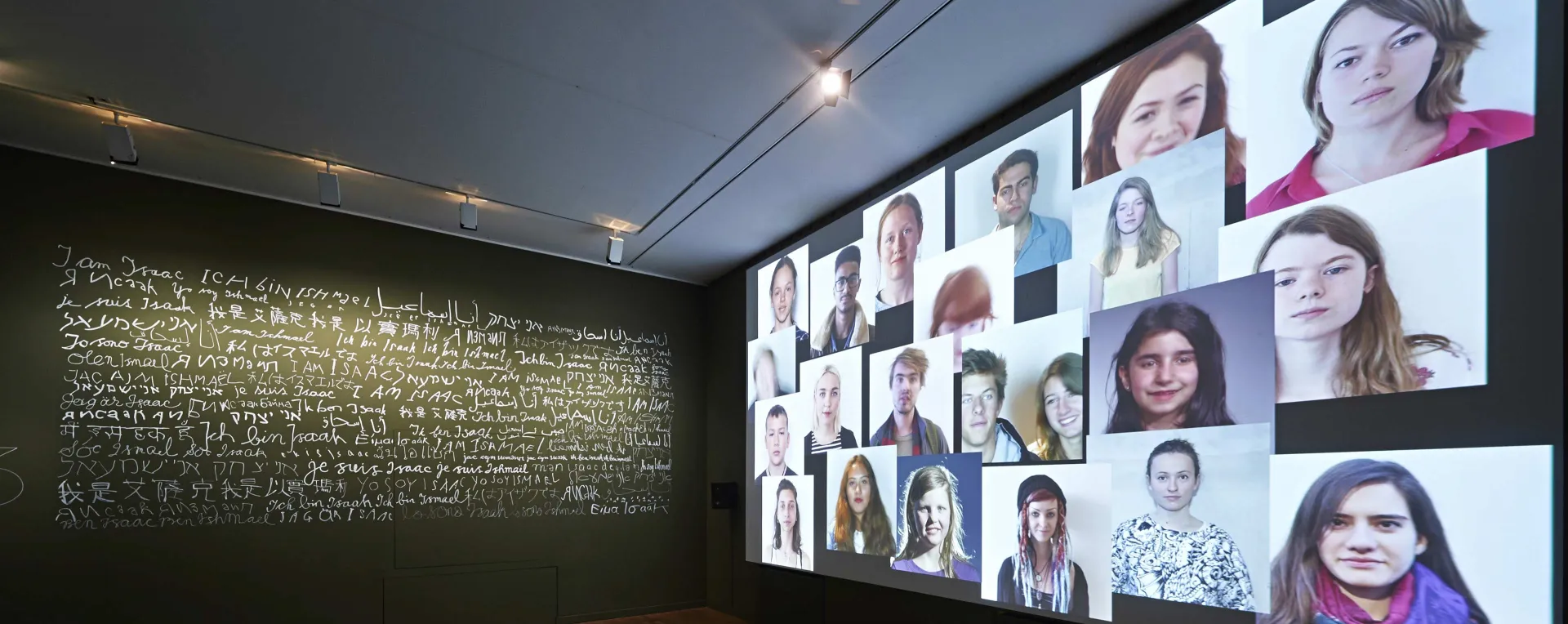
Obedience
An Installation in 15 Rooms by Saskia Boddeke & Peter Greenaway
The story of the patriarch Abraham, who is prepared to obey God’s command to sacrifice his son, is one of the most puzzling episodes of the Bible. That is ample reason to dedicate an exhibition to the “Binding of Isaac,” as the passage is known in Jewish tradition. In Judaism, Islam, and Christianity, it is among the most significant and most popular stories and among the first that were ever depicted. And yet the three monotheistic religions offer very different answers to the questions that the passage raises to this day.
Trailer for the exhibition
The Curators’ Interpretation
In the exhibition, British film director Peter Greenaway and multimedia artist Saskia Boddeke portray the sacrifice of Isaac as a human drama. Which is stronger, God’s command or fatherly love? And where is the modern subject situated between the conflicting priorities of obedience and trust?
Taking these questions as their starting point, Boddeke and Greenaway developed a coherent artistic scenario that approached the biblical narrative subjectively, deconstructed it, and refocused the constituent parts to create an emotionally tangible scenario.
Using film projections, installations, precious objects, and a custom-made own soundtrack, the biblical narrative was staged as a sensory and emotional showpiece in fifteen parts. Its dramatic arc was inspired by the legends of the Jewish, Christian, and Islamic traditions and linked with the experiences and issues of our time.
Impressions of the Exhibition
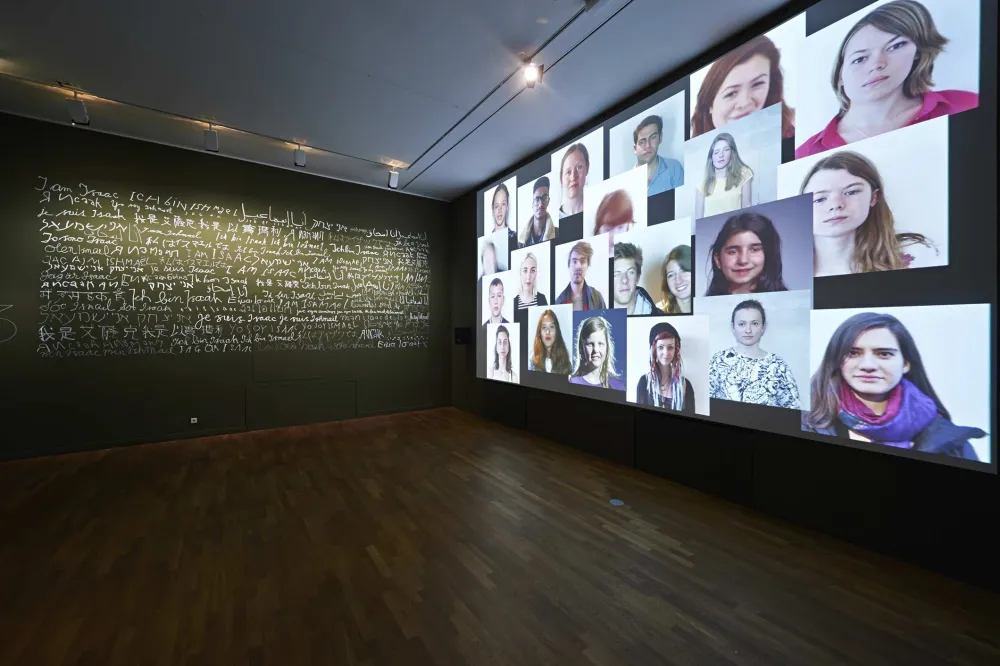
The beginning of the exhibition forms a film installation in which children, teenagers, and young adults greet visitors with the words “I am Isaac” or “I am Ishmael.” The talking faces should invite them to identify with the childlike protagonists of the biblical narrative.
On the walls of the exhibition rooms there are large-formatted projections of dance scenes with performers from the international dance company “Club Guy & Roni.” The dance scenes each illuminate particular aspects of the biblical narrative.
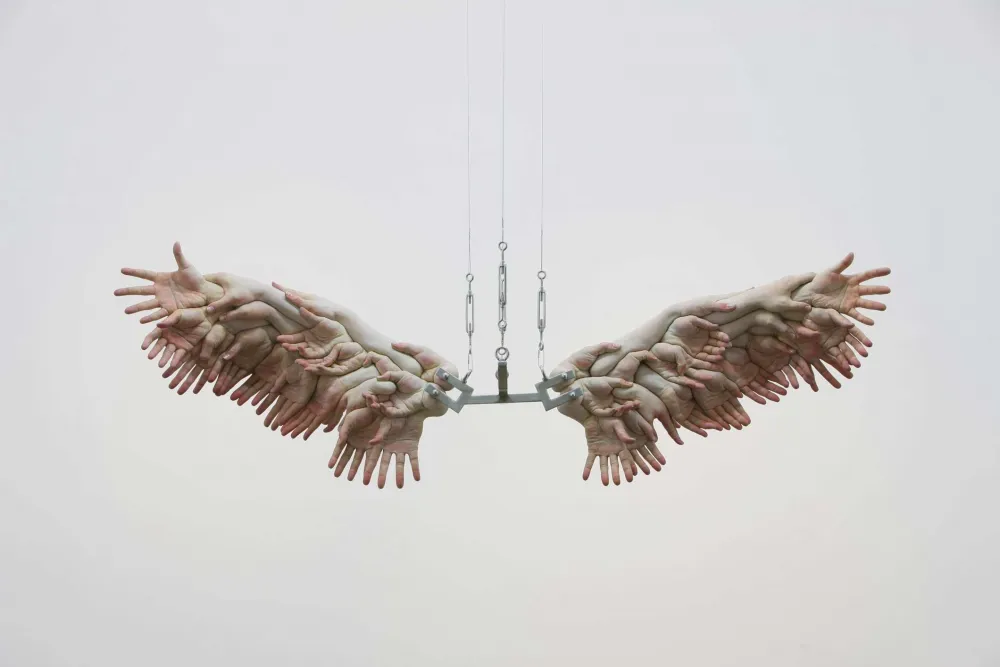
Detailed view of the sculpture The Wings from the white room God and the Angel.
The Wings, Xooang Choi, 2008, Oil on synthetic resin, stainless steel; courtesy of Graywall and the artist.
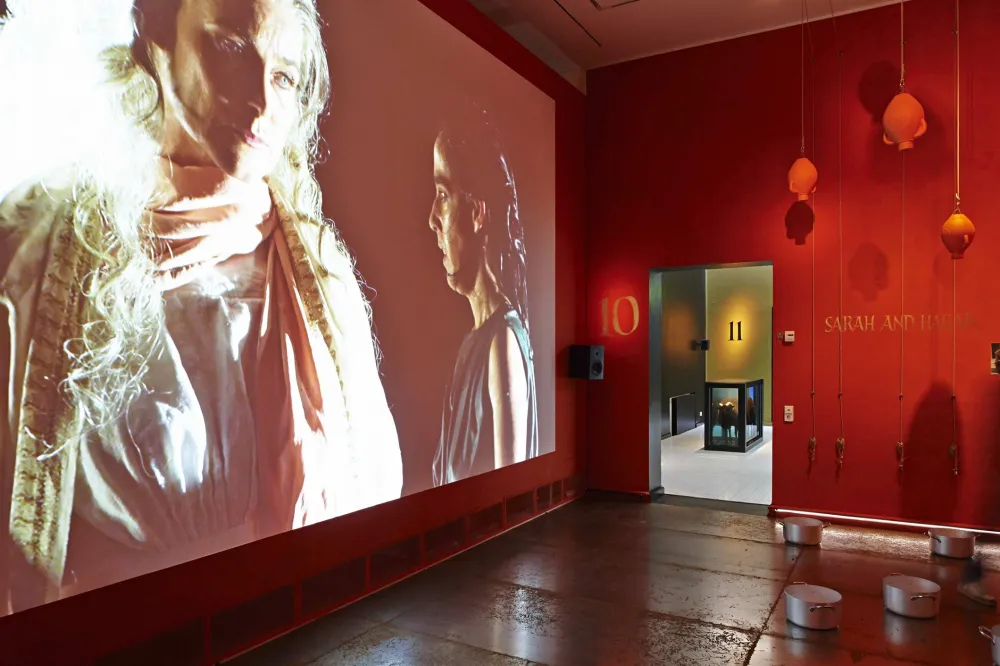
The Room Sarah and Hagar was devoted to the mothers of Isaac and Ischmael; Jewish Museum Berlin, Photo: Yves Sucksdorff.

In the room The Ram Damien Hirst's Black Sheep with Golden Horns (2009) could be seen; Jewish Museum Berlin, Photo: Yves Sucksdorff.
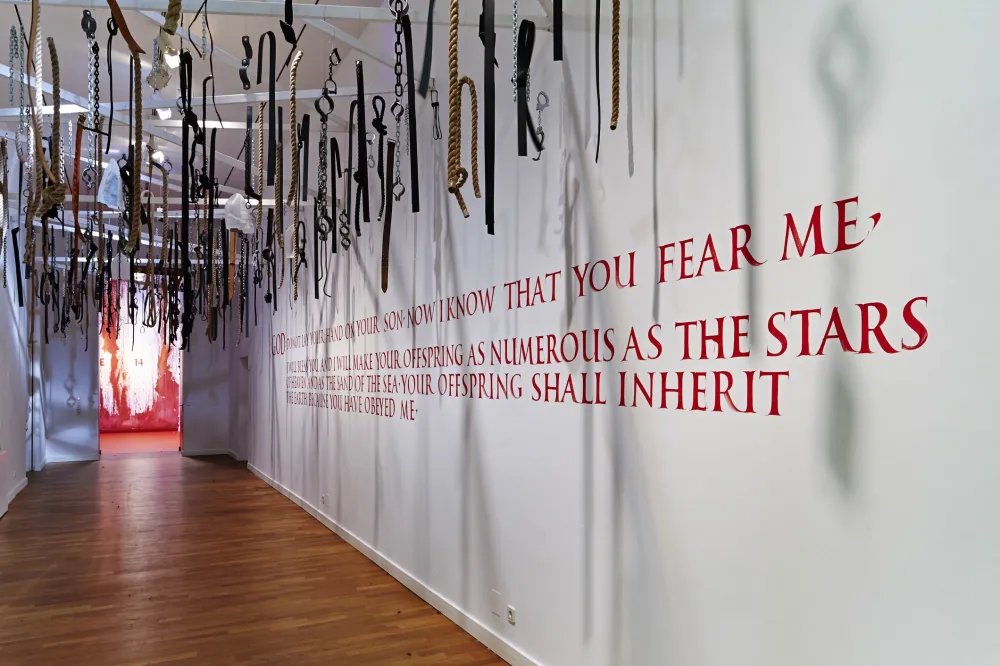
The room The Binding makes reference to the so-called binding of Isaac; Jewish Museum Berlin, Photo: Yves Sucksdorff.
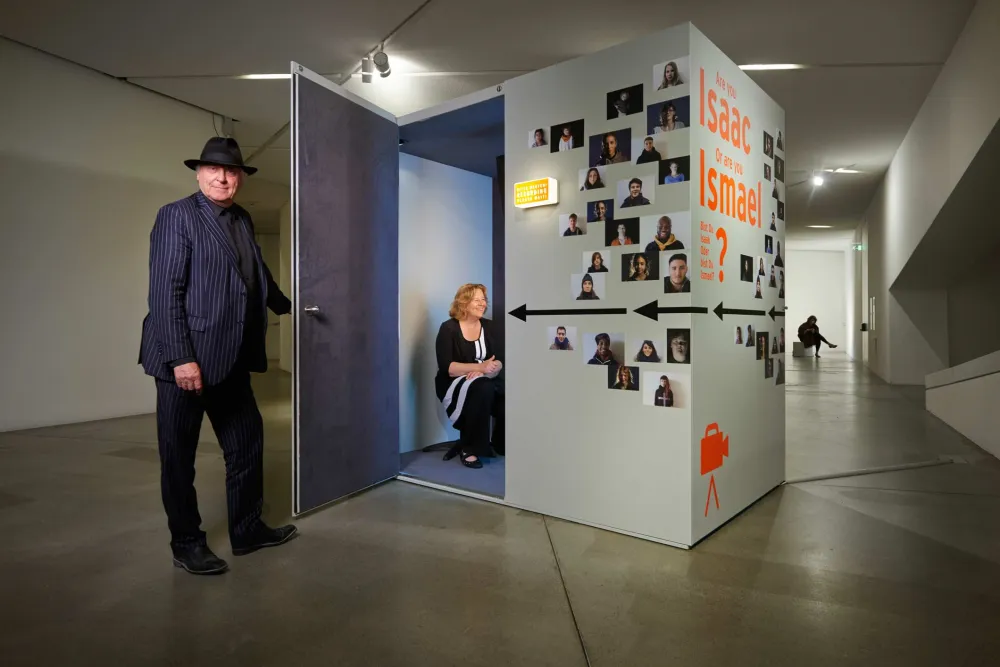
The interactive Video Box I am Isaac/Ismael offers visitors to the exhibition the opportunity to take up the position in front of the camera as Isaac or Ishmael themselves. The Video Box should, similar to the film installation at the beginning of the exhibition, encourage visitors to consider the biblical narrative from a new perspective – that of the child, who will become a victim. Peter Greenaway, Saskia Boddeke, and the Video Box, Jewish Museum Berlin, Photo: Yves Sucksdorff.
Recordings from exhibition visitors from the Video Box I am Isaac/Ismael; more recordings from the Video Box can be found on the
Jewish Museum Berlin Blog.
Credits & Partners
Team Amsterdam
| Directors | Saskia Boddeke & Peter Greenaway |
| Producer | Annette Mosk |
| Editor | Elmer Leupen Jacobine van der Kamp |
| Composer | Luca D'Alberto |
| Choreographers | Roni Haver Guy Weizman |
| Director of Photography | Ruzbeh Babol |
| Calligrapher | Brody Neuenschwander |
| Second Life Artists | Brynley Longman Jo Esmell Bernard Capitaine aka Iono Allen |
| Video Designer | Peter Wilms |
| Sound Designer | Danny Weijermans |
| Light Designer | Floriaan Ganzevoort Maarten Warmerdam |
| 3D Modeller | Chok Wah Man |
| Picture Researcher | Willemien Ruys |
| Set Photographer | Daan van Eijndhoven |
| Installation Photographer | Igor Mandic |
| Production support | Lys Bouma |
| Costume Designer | Willemien Ruys |
| Make-up Designer | Leonie Schuurman |
| Prop master | Jeroen Echter |
| Special Effects | Marten Hoekstra |
| Food Design | Sabrina Hessels |
| Actors/Dancers | Hendrik Aerts Roni Haver Zoe Greenaway Stella van Leeuwen Sofiko Nachkebiya Adam Peterson Igor Podsiadly Skip Rijsdijk Yoav Weizman |
Team Berlin
| Project Management | Margret Kampmeyer-Käding (Curator and Project Manager) Helmuth F. Braun (Director of special exhibitions) Saro Gorgis, Klaus H. Teuschler (Assistance) Anina Falasca, Samuel Zettinig (Research) |
| Production Planning | KatzKaiser Architekten, Köln/Darmstadt: Marcus Kaiser, Tobias Katz |
| Production Management | Tobias Katz Matthias Förster |
| Graphics | Studio Carmen Strzelecki, Köln |
| Media Engineering | Eidotech, Berlin |
| Video booth | Realisierung, Softwareentwicklung und Screendesign: DREINULLmotion, Berlin Außengestaltung: buerominimal Projektmanagement: Jihan Radjai, Mirjam Wenzel |
| Trailer for the exhibition | Compositing & Sound: Sebastian Purfürst, LEM-STUDIOS |
| Exhibition Construction | D4 Project, Berlin Wolfgang Matzat, Berlin Weisse GmbH Eberswalde Dietz Bauservice GmbH, Berlin |
| Collection Management | Anna Golus Petra Hertwig Gisela Märtz Katrin Strube |
| Conservators | Barbara Decker Stephan Lohrengel Adroniki Paliompei Alicija Steczek |
| Set Up | Fißler und Kollegen GmbH, Halsbrücke |
| Painting | Marotzke, Berlin |
| Artistic Surface Design | Mario Kwast Berlin Patrick Gutschmidt Liquid Paint Berlin |
| Electrical and Light Installation | Viktor Kégli, 50Lux, Berlin |
| Décor | Manuel Schubbe, Berlin Bärbel Schütz Plastik Berlin |
| Photo Production | das foto image factory |
| Graphic Production | Bartneck Print Artists, Berlin repro ringel, Berlin |
| Exhibition Organization | Peter Dallmann Gunther Giese (Spie GmbH) |
| Transport | Crown Fine Art GmbH Frankfurt |
| Design of Advertising Campaign | e o t . essays on typography Lilla Hinrichs + Anna Sartorius |
| Marketing | Katrin Möller Sascha Perkins Gesine Tyradellis |
| Press | Jennifer Berndt Katharina Schmidt-Narischkin Sylvia Winkler |
| Online Editors | Mariette Franz Alice Lanzke Mirjam Wenzel |
| Editorial Staff Publications of the Museum | Christine Marth Marie Naumann |
| Construction Team | Anna Augustin Detlef Barrach Mike Bindschädel Michalina Cieslicki Milena Fernando Mariette Franz Miriam Goldmann Lea Heckel Liron Herlinger Julia Jokel André Küter Alexa Stahr Jacob Lippold Peter Litzroth Karla Marsiske Vivienne Noda-Bautista Berrit Pöppelmeier Mareike Poppinga Paul Rehfeldt Glafira Silvestrova Ulrike Sonnemann Oliver Stratz Ann-Christin Wachtel |
Exhibition Information at a Glance
- When 22 May to 15 Nov 2015
- Where Old Building, level 1
Lindenstraße 9-14, 10969 Berlin
See Location on Map
With the support of the Friends of the Jewish Museum Berlin
With support from
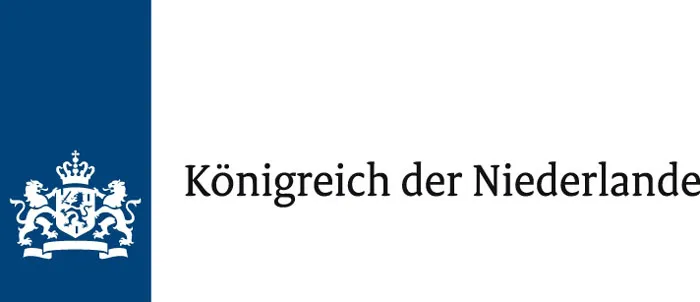
We thank our partner

We thank our media partners




